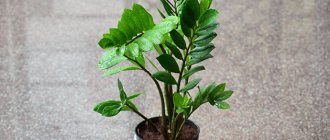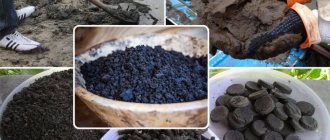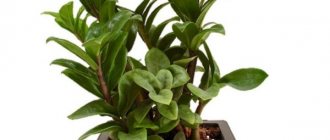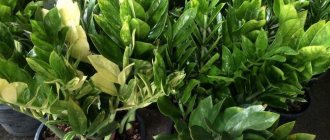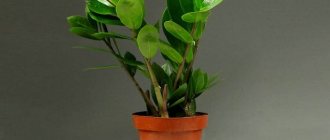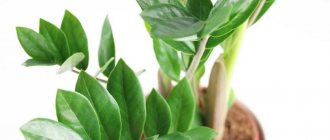Dollar tree: description, photo
Currency, evergreen, money tree are just a few of the names of zamioculcas. This is the only species that represents the flower family Araceae. The plant was described in the 19th century after another botanical expedition. European countries learned about the dollar tree in the 20th century. Later, botanists created several varieties that were used for residential design.
Zamioculcas domestica is a plant that can grow up to 1 m. The tree is classified as a dwarf species. A special feature of the plant is its dense tuberous roots. The leaves are hard, dark green, covered with a glossy coating. The flower appears at the bottom and resembles an ear of corn in appearance. The appearance of the flower makes Zamioculcas even more attractive in appearance. Under the light green shell hides a bud of an unusual shape with a dense structure.
From 2 to 5 buds can simultaneously form on one bush. When describing Zamioculcas, a photo is usually used that shows a yellowish or cream bud. In fact, the flower, which from a distance resembles an ear of corn, consists of small flowers that fit so tightly to the base that they are difficult to distinguish.
Few manage to achieve flowering. Flower growers attribute this to the fact that in a temperate or temperate continental climate, it is difficult to achieve the optimal regime for a lover of the African tropics. Dense, fleshy leaves and tubers can store moisture, which makes them similar to succulent plants. When drought occurs, trees can shed green mass to make their existence easier.
The main task of flower growers who acquired this crop is to provide calm conditions for existence. The dollar flower does not like fuss. Even when transplanting, they try to disturb him as little as possible. Another reason why Zamioculcas is famous is that it belongs to the system of Eastern philosophy of home improvement - Feng Shui. According to ancient teachings, the dollar flower occupies a leading position among plants that can influence financial well-being.
It is believed that if the pot with the currency exchanger is positioned correctly, it will begin to attract money into the house. Additional elements are placed next to it that will attract success and good luck.
What to do with a flower after purchase
The purchase of a dollar tree is always associated with subsequent replanting. An adult plant must be moved to a new container and placed in a permanent place of growth. Store-bought mixtures stop feeding the flower. Sellers feed these species using the foliar method, without worrying too much about the condition of the soil.
Due to the structural features, adult specimens become cramped in small store containers, which are used to save space. The root system is designed in such a way that the roots, growing on the sides, do not go deep, but remain close to the surface. This makes the flower vulnerable; it is not comfortable in small and unstable plastic pots.
Is soil suitable for zamioculcas for cacti, what kind of soil is better to buy?
If you don’t have the opportunity or lack the experience to make your own substrate, don’t despair. You can purchase a ready-made mixture at any specialty store.
The most common ones include:
- Soil for cacti and succulents - provides good breathability, which is important for the normal growth and development of the flower;
- A universal substrate mixed with sand and a small amount of expanded clay or perlite.
These mixtures are in no way inferior in quality to those made by hand. In addition, store-bought mixtures can be a real salvation for a novice gardener, because they will reduce the risk of making a mistake and destroying the plant to a minimum.
How to properly transplant a flower step by step with photos
Transplantation is necessary for zamioculcas in several cases:
- After purchase, to empty it from the magazine container.
- With strong growth of the root system, when the roots begin to rise above the top layer of soil or look out into the drainage holes.
- As a method of propagation by dividing the bush.
- When a plant becomes sick, to save healthy parts.
Transplanting zamioculcas at home is not so difficult if you follow the sequence of actions. Replanting begins with the selection of necessary materials.
The soil. When selecting a mixture, take into account that succulents need moisture and additional air to quickly flow to the bark system. Sod soil with the addition of leaf soil and sifted river sand is ideal for a dollar tree.
Drainage. This is a prerequisite for indoor varieties. Perlite, vermiculite or expanded clay are used for drainage. The drainage layer should be one third of the total volume of the pot.
Capacity. Due to the characteristics of the culture, special attention is paid to the selection of pots. As the root system grows, it becomes heavy, but does not penetrate deep into the ground, and therefore does not have sufficient stability. Therefore, choose heavy ceramic pots with a widened top. This allows you to solve 2 problems at once: to give space to the roots and to correctly place the drainage layers.
A dollar tree is replanted using the transshipment method:
- Before starting the procedure, water the plant abundantly to make it easier to separate it from the store container.
- Then they carefully pull it out along with a lump of earth.
- Place vertically in a prepared pot on drainage.
- Fill the voids with prepared soil mixture.
- Shake the pot slightly to allow the soil to settle.
- The top layer is compacted.
- Then gently water with warm water.
After transplantation, the tree is provided with an adaptation period: during this time it is placed away from the sun. It has not been watered for several days.
The nuances of transplantation at home
The dollar tree needs regular replanting, this is due to the structural features of the root system. Young specimens are replanted every 1-2 years; for adults, replanting is reduced. They can be replanted after 4-5 years of existence.
How often to transplant to another pot
When transplanting zamioculcas annually, choose a container that is several centimeters larger than the previous one. If the capacity for an adult flower becomes too small, then gardeners allow more frequent replanting.
Information! The peculiarity of the species encourages frequent changes of container, but a pot that is too spacious can harm the plant.
The pot for zamioculcas must be stable and dense. There are cases when roots tear plastic containers from the inside. The best option is to choose ceramic and clay materials. The advantage of these containers is the ability of the material to absorb excess moisture with its wide pores.
Replant if the flower is large
Replant a large plant especially carefully after purchase. It is watered generously, then laid on its side and carefully pulled out of the store container. After examining the roots, choose 1 of the options:
- transplant the flower into a large container that matches the size of the root system;
- They divide the tubers into several parts and plant them as independent dollar trees, in this way they not only increase the viability of the plant, but also carry out propagation.
Reproduction
You can propagate a dollar tree in several ways:
- dividing the bush;
- cuttings;
- propagation by leaf blade.
When cuttings, the first root will appear after 1–2 months, and a full-fledged plant can be obtained after 7–8 months.
How to plant zamioculcas using the method of dividing a bush? First of all, the roots are carefully separated from each other, and then each part is planted in the ground as an independent plant and watered very sparingly.
Leaf propagation is the simplest and most accessible method, however, a full-fledged plant will form only after 6–7 months. Each of these methods has its own advantages. Let's take a closer look at them.
Cuttings
The most popular way to get a mini dollar tree specimen. To do this, you only need a good cutting from a mature plant and suitable soil: steamed substrate without humus, fine sand, sphagnum or coconut fiber. You also need to prepare small pots for seedlings or ordinary plastic cups. The main thing is that there are holes in the container to drain the liquid.
However, you need to remember that zamioculcas leaves germinate very slowly: the tuber and roots form in 2–3 months, and you will have to wait up to six months for the first leaves.
The procedure is as follows:
- Cut the zamioculcas leaf at the base and use a sharp knife to carefully divide it into cuttings along the internodes. The correct cutting has 1–2 leaves and a whole leaf node.
- Treat the cut parts with a slurry of activated carbon and water and dry.
- After drying, plant the cuttings in the ground with the bottom of the leaf node.
- Watering is not required for the first two days, then moderate soil moisture is recommended. Along with watering, it is necessary to spray the cuttings with water.
Dollar tree cuttings can be rooted not only in soil, but also in water. In this case, it is much easier to control the rooting process.
- A cutting 7–10 cm in length is cut from the top of the leaf and cleared of the lower leaves, leaving 2–3 at the top.
- The future tree is immersed in a transparent container and filled halfway with water. It is necessary to maintain the fluid level and add it from time to time.
- The roots are fully formed in 2–3 months, after which the plant is transplanted into the ground.
How to grow Zamioculcas from a leaf
Only healthy, large and well-developed leaf blades of adult plants are suitable for propagating a dollar tree using leaves: they contain a sufficient amount of nutrients that allow the new plant to take root and take root.
To propagate Zamioculcas with leaves, follow our instructions:
- Cut off the leaf blade with a sharp knife.
- Treat it with Kornevin or any similar substance that stimulates root formation. Dry the sheet for 2-3 hours.
- Bury the plant 1/3 of the way into moist, loose soil.
- Water regularly but sparingly. It is important not to allow the soil to dry out or stagnate water.
The average period for the formation of the root system is 2 months.
By dividing the tuber
This is the fastest way to propagate zamioculcas, but you should carefully select the material for transplantation: only fully formed specimens with several new growth points on the surface of the earth are suitable.
To successfully divide a plant, you need:
- Carefully and carefully remove the plant from the pot and shake off the roots from the ground.
- Identify parts of the plant that can be separated. They must have their own tuber, roots and a rosette with several leaves.
- Using a sharp knife, divide the root system, trying to make as few unnecessary movements as possible.
- Treat the sections with activated carbon and leave to dry.
- Then plant new plants in separate containers and water.
Care after transplant
Caring for the dollar flower is easy. It is important to establish a system of care and follow it.
Lighting and placement
Zamioculcas feels comfortable on south-eastern or south-western windows. The leaves should receive diffused light, while direct exposure to the sun should be avoided. The rays contribute to the formation of burns on leaf plates. If the dollar tree is too hot on the selected windowsill, it will react by losing the rich shade of the plates, the leaf will become soft and limp.
Advice! When grown on a windowsill, Zamioculcas is regularly rotated 45° so that light reaches all parts. Constantly placing the pot in one position leads to deformation of the stems due to the fact that they are drawn to sunlight.
Temperature and humidity
The culture grows at temperatures from + 20° to + 26°C. An increase in temperature makes the flower sluggish and stunted; a decrease to + 6°C can lead to freezing. Humidity is not so important for Zamioculcas. Spraying is carried out no more than once a week. It is recommended to wipe the leaves with a damp cloth because dust quickly accumulates on the surface. Have a monthly hygienic shower, after which excess moisture is shaken off or dried with paper napkins.
Information! During the dormant period, the temperature can be reduced to + 18 °C.
Watering and fertilizers
Watering is necessary when the top layer is completely dry. In summer, the pot is watered more often; in winter, it is limited to 2-3 waterings monthly. As a succulent, the tree is capable of storing moisture, so overwatering is harmful to it. Stagnant water or an ill-conceived drainage system can lead to rotting of the roots.
Fertilizing is applied during the period when the flower is actively growing green mass. After transplantation, about 2 weeks should pass before the first fertilizing is applied. The main elements that succulents need are magnesium and potassium. Solutions are applied at the root, so you should carefully monitor the volume of water for irrigation and solutions with fertilizers so as not to over-moisten the soil.
Information! Water for irrigation must be left standing for at least 24 hours. Watering with cold water is excluded.
Trimming
Caring for zamioculcas after transplantation includes the mandatory formation of a bush. At the transplantation stage, it is allowed to prune damaged, non-viable stems. Then pruning is carried out twice: in autumn and spring. Spring pruning is used to form a bush: remove side shoots that spoil the appearance of the plant and make it unstable, and also remove diseased parts. In the fall, additional pinching is done before the onset of the sleep phase.
Information! Shape-forming pruning is carried out with protective gloves, since the cell sap contains toxic substances.
Common growing mistakes
If you follow the basic rules, it is quite possible to get your dollar tree to bloom. To grow zamioculcas, it is necessary to establish a control system and not change the procedure. Even the most experienced gardeners have problems when growing indoor species.
| Problem | Cause | Solution |
| Leaf blades turn yellow completely | Sudden temperature changes, drafts, possible freezing | Change the location of the pot, avoid drafts |
| The tips of the leaves turn yellow | Dry air, high temperature | Humidify the air near the potty, arrange a hygienic shower |
| The leaves turned yellow and completely fell off | Drought, prolonged lack of watering | Transplant the dollar tree into another pot, trim the stems when replanting |
| Slow growth | Transplantation, rest, incorrect choice of container | Avoid root rot and monitor the plant |
| Dark spots on the stem | Rotting of parts of the root system due to overwatering | Stop watering, replant if necessary, after drying the roots with a napkin and removing damaged |
Sometimes gardeners can detect drops of water on leaf blades, although they have not been sprayed or watered by sprinkling. This may mean the plant is crying. This phenomenon signals a violation of watering rules. Excess moisture, excessive air humidity activates the plant’s ability to get rid of water through the leaf plates.
Constant dampness in the tray or excessive humidity around the pot causes pests to appear. Due to dampness, insects such as scale insects and flower midges appear. In summer, you can get rid of them by treating with a manganese solution and moving the pot to fresh air.
Dampness and excessive watering lead to the appearance of fungal diseases. Curlyweed suffers from anthracnose and powdery mildew. When the first signs appear, treat with fungicides. A good option is to manually process the leaves with a solution of laundry soap or tobacco.
Diseases and pests
Zamioculcas is susceptible to attacks by the following insects:
- scale insect;
- aphid;
- spider mite;
- mealybugs;
- thrips.
Having discovered parasites, you should review the care: watering regime, adjust the humidity and temperature in the room where the tree is grown. As a preventative measure, it is necessary to frequently inspect the plant, and at the first sign of an insect attack, use specialized preparations.
Zamioculcas is susceptible to some diseases, including root rot, the appearance of dark spots, and yellowing of leaves. The causes of diseases also lie in improper care.
